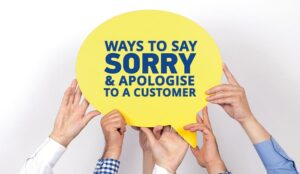It is suggested to apologize sincerely to the customers when necessary; however, not always a mere “I’m sorry” works well.
We can use many other phrases instead of saying sorry for these situations. The customer service representatives should know when to apologize and what to say instead of saying sorry to the frustrated customers. This article walks you through the steps of apologizing in customer service.
7 Tips on Apologizing to the Customer
Before talking about what to say instead of sorry in CS, let us discuss the principles of apologizing to the customers. This section provides you with some great tips on making a perfect apology to your frustrated customers.
1. Listen to the Customer Carefully
Customer service agents must be sure of what they apologize to the customer for if they want to look honest.
The agent can assess and clarify the problem, ensuring that everyone is on the same page while appearing honest and attentive.
This approach helps the customer service because the agents can personalize the apology to make it more genuine.
Listen carefully and ask the correct questions to determine what you apologize for.
2. Try to Make No Assumptions
Many customer service agents cut corners during the support calls and make assumptions based on previous encounters with customers with similar issues.
These assumptions are the enemy of a genuine apology and frequently lead the agents to make judgments that are not in the best interest of the specific customer.
Agents frequently make assumptions about what the customer says because they have heard it before. Still, effective listening is critical to having an apology to the customers.
They jump in with what they see as the answer, thinking it to be in the customer’s best interest, sometimes to save the customer’s time, and sometimes to lower their Average Handling Time (AHT). However, this is not the case in most cases!
Most angry consumers want to vent their frustrations and need to express themselves. You rob them of that by leaping to the solution without first hearing them out.
The first step is to let the customer vent, which will help you find out the entire scope of the situation via listening and questioning, adding legitimacy to your apologies.
3. Reassure and Provide a Sense of Urgency
Not everything gets instantly correct when an apology has been made. After acknowledging the problem, you should express your plans so that the apology seems genuine.
Next, clear up any ambiguity by stating that you are working to solve their problem. Talk in a way that implies you are their assistant within the organization.
It gives the impression that you are on the customer’s side, which helps to build rapport. Use active verbs to reassure the customer that you are already working on solving their problem.
Instead of “This will be resolved before Tuesday,” use, “I will resolve this before Tuesday.”
In light of this, the followings are some soothing remarks that can use instead of saying sorry to create a sense of immediacy.
These should be used along with a proper apology:
- As I look into it, I have found…
- I am performing [the task] to assist you.
- You were correct in bringing this to my attention, so I can [the task].
While these statements are likely to be helpful, make sure that any promises you make to consumers, such as providing time estimates, are ones you can keep. For example, it prevents you from enraging an already disgruntled customer.
4. Take Charge of the Situation
Giving your full name as a customer service agent is the first step to taking responsibility in contacting the customers.
There is also a case to be made for taking ownership before making an apology, perhaps as part of the initial greeting.
Maybe the intended situation was unintentional; however, the buyer is entitled to explain what went wrong.
You can re-establish trust by taking responsibility for the problem and committing to the customer.
While we have been using personal pronouns like “I,” “you,” and “me” to imply that we are taking responsibility for the problem, making a straight confession of responsibility reinforces apologies.
Commitment gestures can also be employed for this reason, as they help reassure clients by indicating that their problem is a personal priority of yours.
If you are wondering what to say instead of sorry in customer service, these are examples of commitment statements:
- I will do all to resolve this by tomorrow.
- I will get back to you as soon as I have more information.
- I will work on resolving the issue and contact you as soon as possible.
5. Make an Honest Apology
Put yourself in the client’s shoes and try to understand why they are irritated. Customers want to know that their concerns have been taken into account.
Empathy is an essential component of an honest apology. It shows mutual understanding and the establishment of trust; hence, it plays a crucial role in an apology.
The customers want to feel as if the person they are speaking with understands the issue, and they want someone to apologize sincerely.
Empathy also aids in the validation of the customer’s feelings. It is much easier to turn around a difficult situation if people feel appreciated.
Personalization is another excellent practice to use the customer’s language when creating rapport, and it is also a good practice when apologizing to a customer.
It is critical to examine and define the customer’s issue before thinking about what to say instead of saying sorry and providing proper apologies.
You imply mutual understanding and that you have thoroughly listened to the customer’s concern by reflecting on their issue in your apologies.
Here are a few examples of empathy and personalization to create a customer service apology statement:
- I am sorry; I understand how frustrating [the problem] was for you.
- Please accept my sincere apologies; I understand how difficult it must have been for you to deal with [the problem].
Thank you for bringing [the problem] to our attention. I understand that this has not been easy to cope with, and I apologize if we have made you feel upset.
6. Close the Apology
Before summarizing your solution and informing them of what occurs next, repeat the apology to emphasize your remorse that they had to call in.
Summarizing your solution is essential since it allows you to show the consumer all you have done, while the following steps are helpful for customers who want to go on with their busy lives.
While repeating the “sorry” is OK in this situation, try not to do so too frequently during the call since it may devalue your previous apology.
The following sentence is an example of a closing comment you could use to “close the apology.”
- I apologize for calling today; we were able to [the solution]. Our next steps are [something] now that we have completed that.
7. Offer a Solution to Show Collaboration
After taking responsibility, comforting the customer, and apologizing, it is time to focus on turning the situation around and finding a solution.
So far, the emphasis has been on using the pronoun “I” in the customer support agent and apologizing to “you” in the customer’s role.
Go from “I” to “you” and then to “us” as in what do I need from you so that we can tackle this problem together.
These are some examples of what to say instead of sorry and how to give solutions to the customers:
- It is a complex scenario, but we could try [something] as a solution.
- Now that I am aware of the situation, we can work to [something] to resolve it.
- I would feel the same way if I were in your shoes. I would try, and what I recommend we attempt as well is to [something].
As a final guideline, your focus should now be on the solution rather than the problem. It contributes to the interaction’s upbeat tone.
What to Say Instead of Sorry to the Customers?
In the customer service calls, you can use the following statements to apologize to the customers instead of saying sorry along with the statements mentioned above.
- Can you tell me whether this has happened before?
- Tell me about the impact this has made on your…
- Please explain how you feel about it.
- I am sorry; I understand how frustrating [the problem] was for you.
- Please accept my sincere apologies; I understand how difficult it must have been for you to deal with [the problem].
- I would feel the same way if I were in your shoes. What I’d try, and what I recommend we attempt as well, is to [the solution]
What to Avoid When Apologizing in Customer Service?
When it comes to apologizing to customers, customer support representatives frequently make several blunders that help to exacerbate the problem.
While the apologetic lines listed above will assist you in avoiding these problems, you must avoid the following.
Do not say, “I’m sorry for any inconvenience” instead, try, “I’m sorry you feel that way.”
Using words or phrases like “any,” “if,” and “feel that way” puts doubt on any earlier feelings conveyed by the consumer, detracting from the apology’s sentiment.
To show that you are on the customer’s side, use pronouns like “I” and “you” in your apologies.
The word “we” in customer service does not convey to the customer that you are personally concerned about them and their problems.
Also, avoid overly formal language. Instead of saying, “I am sorry,” say, “I’m sorry.” Try to use conjugations instead of single words.
It will make your apology sound more genuine, as you do not want to come across as robotic while apologizing.
This article tried to cover what to say instead of sorry in customer service interactions with customers. It also offered some phrases instead of saying sorry to CS agents.
Finally, after finishing the apology, all left is to ask the customer if they have any more questions and then end with a kind call-closing comment. If you want to go extra, AI-Analytics can analyze 100% of your agent-customer conversations.
Identify the opportunities to improve CX, drive revenue growth, boost operational efficiency and mitigate compliance risk.
For more information about Scorebuddy - visit the Scorebuddy Website
Call Centre Helper is not responsible for the content of these guest blog posts. The opinions expressed in this article are those of the author, and do not necessarily reflect those of Call Centre Helper.
Author: Scorebuddy
Published On: 12th May 2022 - Last modified: 28th Apr 2023
Read more about - Guest Blogs, Scorebuddy






 Scorebuddy is quality assurance solution for scoring customer service calls, emails and web chat. It is a dedicated, stand-alone staff scoring system based in the cloud, requiring no integration.
Scorebuddy is quality assurance solution for scoring customer service calls, emails and web chat. It is a dedicated, stand-alone staff scoring system based in the cloud, requiring no integration. 





























